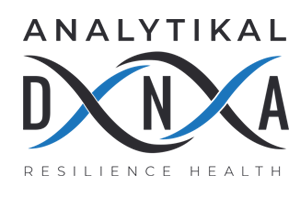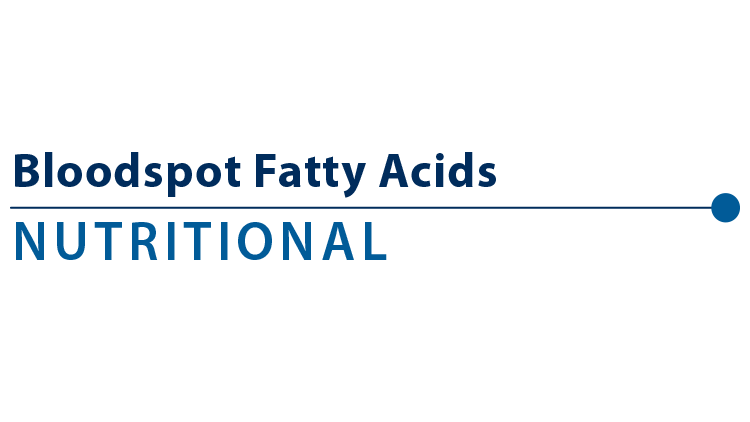Description
A Convenient Finger-Stick Test for Evaluating Key Fatty Acids
Why Use the Fatty Acids Profile – Bloodspot?*
Fatty acid imbalances can be a causative factor in a variety of chronic health conditions. The Fatty Acids Profile – Bloodspot assesses the critical balance between essential Omega-6 and Omega-3 fatty acids. The Fatty Acids Profile – Bloodspot can indicate the need for fatty acid supplementation and/or dietary modification.
Effective for Patients Experiencing:
The Fatty Acids Profile – Bloodspot is useful for patient concerns including:
- Chronic Pain/Inflammatory Conditions
- Depression
- Cardiovascular Risk
- Weight Issues/Dietary Guidance
About the Fatty Acids Bloodspot Profile
The Fatty Acids Profile – Bloodspot is ideal for those without access to blood-draw facilities. The Fatty Acids Bloodspot Profile reports results in an easy-to-interpret quintile format, and also provides a Supplement Recommendation Summary based on test results.
The complete Fatty Acids Profile – Bloodspot measures:
- Polyunsaturated Omega-3 Fatty Acids
- Polyunsaturated Omega-6 Fatty Acids
- Trans Fatty Acids
- Fatty-Acid Ratios
Clinical Overview
What is the Fatty Acids Profile – Bloodspot?
Fatty acids are the core building blocks of cellular membranes making them critical for cell membrane structure and function as well as local signaling. Essential fatty acids (EFAs) cannot be synthesized by the human body and must be obtained in the diet or through supplementation. EFAs are transformed into local hormonal mediators called eicosanoids, a process vital in the ability of the body’s immune system to repair and protect itself and to regulate inflammation. The Fatty Acids Profile – Bloodspot is a convenient finger-stick test that can illuminate problems in essential fatty acid absorption and metabolism, which significantly impact cellular functions, intracellular communication, and neurological/brain development
The Fatty Acids Profile – Bloodspot reports fatty acid levels for:
- Polyunsaturated Omega-3
- Alpha Linolenic (ALA)
- Eicosapentaenoic (EPA)
- Docosahexaenoic (DHA)
- Polyunsaturated Omega-6
- Linoleic (LA)
- Gamma Linolenic (GLA)
- Dihomogamma Linolenic (DGLA)
- Arachidonic (AA)
- Trans – Total C:18 Trans Fats
- Fatty-Acid Ratios
- LA/GLA
- AA/EPA
- EPA/DGLA
- Index of Omega-3 Fatty Acids
When Should the Fatty Acids Profile – Bloodspot Be Considered?
Essential fatty acid imbalances have been associated with a number of health disorders, including: inflammatory disorders, cardiovascular issues, hormonal disorders, autoimmune disorders, arthridities, senile neurological degeneration, mental and behavioral disorders, attention deficit hyperactivity disorder (ADHD), insulin resistance and obesity, and hair and skin related conditions.
What Advantage Does the Fatty Acids Profile – Bloodspot Offer Compared to Other Diagnostics?
With just a simple finger stick, this easy-to-use bloodspot test offers a convenient alternative to a blood draw in determining the status of key essential fatty acids. This profile is a practical option for clinicians without access to blood-draw facilities.
Advantages of bloodspot testing:
- Easy to implement in any practice
- Does not require venipuncture
- Cost-effective testing and therapy
- Easy enough for patients to use at home
- Simple and economical option for follow-up testing
What Can Clinicians and Patients Expect from Fatty Acids Profile – Bloodspot testing?
Fatty Acids Profile – Bloodspot testing can indicate the need for dietary modifications and/or fatty-acid supplementation. With knowledge of a patient’s full medical history and concerns, the Bloodspot Fatty Acid – Bloodspot test results may be used by clinicians to create a personalized support program. The report includes a Supplement Recommendation Summary for essential fatty-acid oils and amounts indicated by test results, which may help to support fatty-acid sufficiency and balance.



